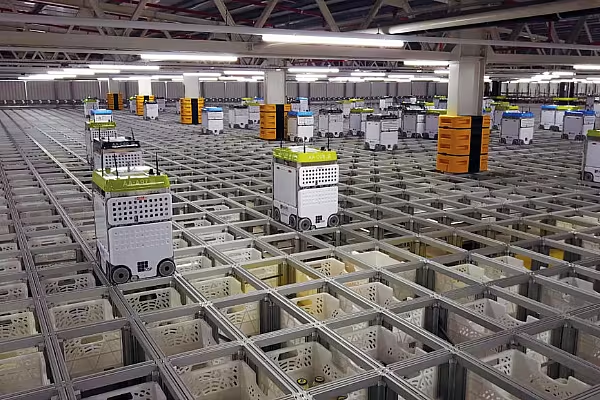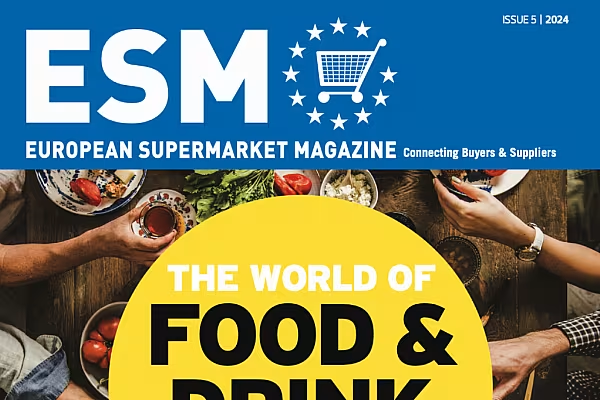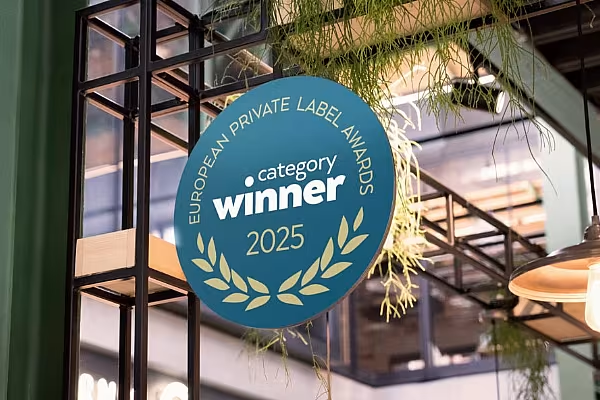Over the past year, online-only retailer Ocado has cast its net internationally, with the development of its Ocado Smart Platform. Stephen Wynne-Jones spoke to Ocado Solutions CEO Luke Jensen. This article appeared in ESM Issue 1, 2019.
As investment opportunities go, online-only supermarket player Ocado is very much a long game. Having famously taken 15 years to turn over its first full-year pre-tax profit, the slow adoption of grocery e-commerce in the British marketplace has no doubt tested the patience of CEO Tim Steiner and his team in the years since the company was founded, back in April 2000... the heady days of the dotcom bubble.
Fast-forward to the present day, however, and Ocado is going places – literally. The formation of the Ocado Smart Platform in 2017 (which forms part of its Ocado Solutions business), has seen the company offer its technology to retail third parties for the first time, and has given the group a presence in markets such as France, Sweden, the US and Canada. The platform also helped lift Ocado’s share price to a high of £1,146 last summer – a world away from the £230 to £250 mark at which it was trading back in late 2017.
Ocado announced its full year results on 5 February, in which it said that revenue from the Solutions business rose by 15.8% to £123.0 million (group revenue was £1.6 billion, a 12.3% rise). Announcing the results, CEO Tim Steiner said that the retailer’s “growth story [...] is only just beginning”, noting that Ocado is looking forward to new opportunities with “excitement and determination”.
Few who have tracked Ocado over the two decades since its formation would disagree with him.
Establishing A Foothold
“Ocado has always taken a very open-minded, prepared-to-rethink-anything attitude,” says Luke Jensen, the chief executive of Ocado Solutions since early 2017. “It has shown over the years how it has been able to deconstruct online grocery, how to do things more efficiently, and how to invest in the customer proposition.”
Jensen joined Ocado from Boston Consulting Group, and prior to that, he was a member of the executive committee at Sainsbury’s (from 2008 to 2014), wherein his responsibility included the ‘overall digitalisation’ of the business.
Historically, the UK market has been quite pioneering in terms of e-commerce – at the turn of the millennium, both Tesco and Asda had online shopping channels – and, thus, in order to develop a point of difference, Ocado developed “increasingly exceptional technology,” Jensen explains, in order to develop a situation in which it boasted “not just the best grocery technology in the UK, but also the best in the world.”
The potential to achieve something larger with said technology was first evidenced in 2014, when Morrisons, which historically had shunned online grocery, came knocking at Ocado’s door.
“The deal with Morrisons was fairly straightforward,” says Jensen. “Morrisons essentially piggybacked on Ocado’s operations. It shares half the capacity in one of our big automated warehouses close to Birmingham, and 30% of the capacity of our new warehouse in Erith.
“When the Morrisons deal was established, everyone, both internally and externally, said, ‘Wait a minute. If we can sell our technology to Morrisons, technically, we can sell it to other businesses as well.’”
State Of Play
It was a eureka moment, but one that took some years to realise. Given that both Ocado and Morrisons were British based, the group realised that this was “not something that we could just package up and replicate internationally,” says Jensen.
“The technology was Ocado’s historic technology. The warehouses were already owned by Ocado. This was not something that was going to work in other markets.”
The side of the business that would come to be known as Ocado Solutions needed to be “rewritten in a way that was going to be much more user-friendly to other retailers, backed by warehouse robotics technology that was scalable, both down and up, and transportable around the globe. We needed to bring in talent and capabilities to adapt to other retailers’ needs, and develop partnerships that would have real longevity.”
After several years of development and countless industry rumours, Ocado Solutions’ breakthrough moment took place in November 2017, as the group penned a deal with Groupe Casino to develop the Ocado Smart Platform in France. The agreement will see the development of a customer fulfilment centre (CFC) outside Paris, set to open in early 2020 and powered by Ocado technology, to assist the Monoprix banner in the development of a more efficient, responsive online platform.
Agreements with Sobeys (in January 2018), ICA (May 2018) and Kroger (October 2018) followed, all based on the same structure. In partnership with said retailers, Ocado would develop CFCs – as many as 20 CFCs in the case of Kroger – to support the growth of the respective online portals. Ocado Solutions was up and running.
The Long Game
Among analysts, however, Ocado’s strategy has received a cautious welcome. Last October, Barclays European Food Retail Equity Research said in a briefing note, ‘Ocado may be well positioned to sell its technology to grocers who want to make the move online. Although working with Ocado involves paying significant fees, it might also be seen as a “best-in-class” solution and appear to be a lower-risk option than “going it alone”.’
Jensen dismisses suggestions that there is a trade-off between adopting Ocado’s technology and ‘going it alone’, as Barclays suggests.
“I don’t think that’s realistic,” he says. “We’ve invested more than half a billion pounds. We’ve got 1,400 software developers and hundreds of mechanical engineers. No retailer is going to come anywhere near that in terms of the ability to do it themselves.”
As to the initial cost outlay of both parties – retailers need to commit to a certain upfront fee structure, as well as ongoing fees linked to sales achieved, while Ocado is required to dip into its cash pool to inaugurate CFC development for each – Jensen rejects ESM’s suggestions that there is an element of blind faith about the agreements.
“It’s not blind faith at all,” he says. “We have a pretty good idea of what it costs us in terms of capex, as well as a good line of sight in terms of how we are bringing those capex costs down. We are very confident, both for ourselves and for our retail partners, that this will create a profitable business for us and a profitable business for them.”
Long-Term Partnerships
Ocado notes that its agreements with retailers are long-term partnerships – no off-the-shelf solutions here – and this works both ways: just as Ocado will look to stay ahead of trends and facilitate its partners thusly, so it will take findings from each of the firms with which it works and develop solutions around the same.
“It then creates an incredible ‘innovation machine’ that can respond to their needs and develop common solutions that will be of value to all,” says Jensen.
Over time, the costs associated with running Ocado’s services – such as automation costs – will decline, improving the margin potential for Ocado and facilitating further investment in its operations.
“We are very aware of the fact that we will have to continue to invest a proportion of that value creation to pave the way to a long-term future,” says Jensen.
The group also recognises that, while as much of 90% of the modus operandi of major retailers remains the same around the world, each operator has its nuances. ICA, for example, is largely a retailer-owned network of stores, rather than a top-down structure.
“For ICA, we are developing an extra, bespoke feature whereby users of the ICA platform can select the retailer they shop at, and are presented with the range, promotions, etc. that apply to that store,” says Jensen. “That system is supported by one common operation that serves all ICA retailers: the group can still avail of benefits of scale and the facility for order preparation that other retailers have.”
ESM also suggests that Ocado’s platform may be more suited to some markets more than others. Germany, for example, has seen a marginal adoption of online, both at a retailer and a consumer level, owing to a high frequency of stores and low margins in the sector. Jensen believes, however, that no market is out of bounds.
“Ultimately, if enough people want something, the market is going to develop,” he says. “When that happens, retailers in that country will say, ‘This is something I have to focus on. I can’t ignore it, and I need to do it as effectively as possible.’”
Next Steps
In terms of the future growth agenda for Ocado Solutions, Jensen is keen to bring more retailers into the fold, but he is also conscious of the need to get the current agreements fully operational before taking on too much new business. Following the opening of the Paris CFC in early 2020, further CFCs are due to open in Stockholm (for ICA), Toronto (for Sobeys) and Ohio (for Kroger).
“There’s a lot of growth embedded into those partnerships,” he explains, “but, yes, we clearly see that there’s a lot of demand out there, and we’ve got a big-enough profile now that there are businesses looking to speak to us.
“With each retailer we work with, it’s about developing a partnership underlined by an ambition to become a leader in their market. We will be successful where our clients will be successful.”
© 2019 European Supermarket Magazine – your source for the latest retail news. Article by Stephen Wynne-Jones. Click subscribe to sign up to ESM: The European Supermarket Magazine












